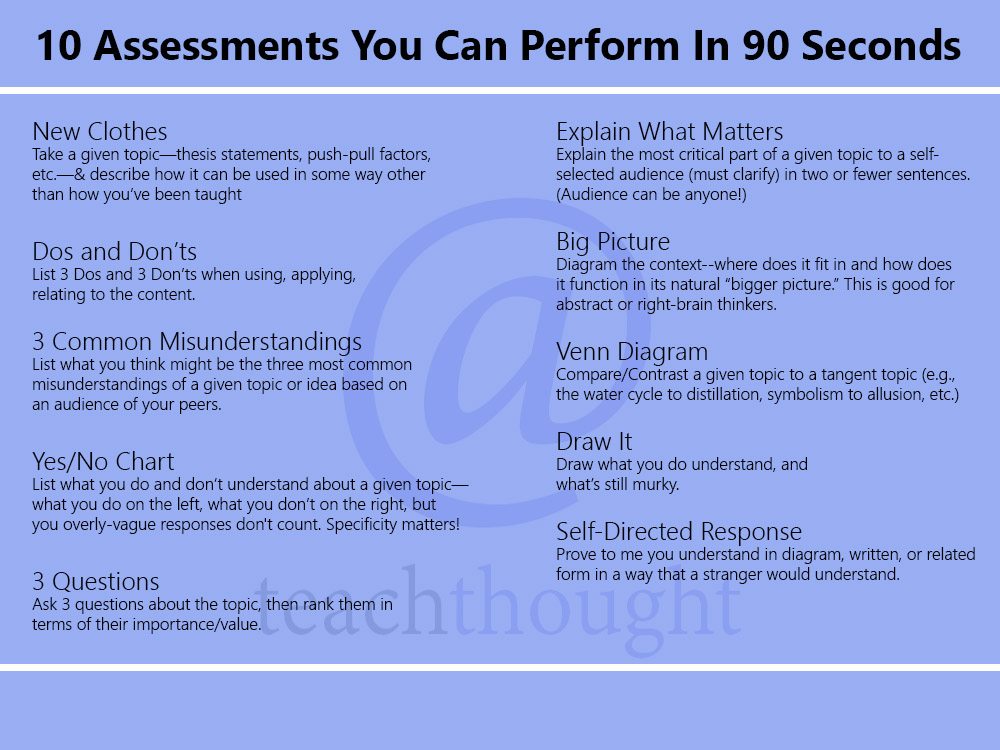
10 Simple Assessments You Can Perform In 90 Seconds
by TeachThought Staff
Good assessment is frequent assessment.
Any assessment is designed to provide a snapshot of student understand—the more snapshots, the more complete the full picture of knowledge.
On its best day, an assessment will be 100% effective, telling you exactly what a student understands. More commonly, the return will be significantly lower as the wording of questions, the student’s sense of self-efficacy, or other factors diminish their assessment performance. It sounds obvious, but a student is a human being with an entire universe of personal problems, distraction, and related challenges in recalling the information in the form the assessment demands.
This makes a strong argument for frequent assessment, as it can be too easy to over-react and “remediate” students who may be banging against the limits of the assessment’s design rather than their own understanding. Rather than re-teaching, sometimes all that is necessary is re-measuring.
It is a huge burden (for both teachers and students) to design, write, complete, grade, and absorb the data into an instructional design sequence on a consistent basis. So why not frequent, simple assessments?
Simple Assessments
The word ‘simple’ here is misleading. Rather than describing the cognitive load on the student, it instead describes the complexity of the assessment form itself. The simpler the assessment—in terms of process and logistics—the more ‘purely’ it can function as a tool to get at what a student actually understands, and help you identify how to help them.
Then, due to their brevity, they’re simple to grade–in fact, you can grade them as exit slips–which makes taking the data and informing instruction (the whole point of assessment) a much simpler process as well.
1. New Clothes
Take a given topic—thesis statements, push-pull factors, the scientific process, etc.—and describe how it can be used in some way other than how you’ve been taught.
Example of Student Response: We’ve learned the scientific process by looking at how actual scientists study new things, but the scientific process would also make an excellent tool for detectives to use while pursuing criminals. It would allow them to observe data, form theories, test theories while collecting more data, and draw conclusions that can then be judged in a court of law.
2. Dos & Don’ts
List 3 Dos and 3 Don’ts when using, applying, relating to the content (e.g., 3 Dos and Don’ts for solving an equation).
Example of Student Response: When adding fractions, DO find a common denominator, DO add the numerators once you’ve found a common denominators, DON’T simply add the denominators
3. Three Most Common Misunderstandings
List what you think might be the three most common misunderstandings of a given topic based on an audience of your peers.
Example of Student Response: In analyzing tone, most people probably confuse mood and tone, forget to look beyond the diction to the subtext as well, and to strongly consider the intended audience.
4. Yes/No Chart
List what you do and don’t understand about a given topic—what you do on the left, what you don’t on the right, but you overly-vague responses don’t count. Specificity matters!
Example of Student Response: In learning about paragraph structure (Do Understand): what a topic sentence is, how many sentences a paragraph should have, that a paragraph should be about one idea; (Don’t Understand) how a paragraph can have a conclusion, how to know when I’ve given enough supporting details in the paragraph, how to revise a paragraph
5. Three Questions
Ask three questions about the topic, then rank them in terms of their importance/value.
Example of Student Response: Low Importance: Does the prefix “tri” mean 3? Medium Importance: Is the triangle the only 3-sided geometrical figure? High Importance: Why don’t triangles show up very often in nature (as so many other shapes do)?
6. Explain What Matters
Explain the most critical part of a given topic to a self-selected audience (must clarify) in two or fewer sentences. (Audience can be anyone!)
Example of Student Response: The most important part of a thesis statement is clarity and conviction, so I’ll explain that one to Jay-Z: A thesis statement is kind of like the hook or title of one of your songs–it delivers the message that the song goes on to explain. Feel me?
7. Big Picture
Diagram the context–where does it fit in and how does it function in its natural “bigger picture.” This is good for abstract or right-brain thinkers.
Example of Student Response: It is impossible to understand the rules we live by and how they’re formed without understanding the 3 branches of government.
8. Venn Diagram
Compare/Contrast a given topic to a tangent topic (e.g., the water cycle to distillation, symbolism to allusion, etc.)
Example of Student Response: A Venn Diagram comparing and contrasting symbolism and allusion, or tone and mood.
9. Draw It
Draw what you do understand.
Example of Student Response: A drawing of what an adjective thinks about a noun, or a how much smaller in size the thousandth’s place is compared to the ten’s place.
10. Self-Directed Response
Prove to me you understand in diagram, written, or related form in a way that a stranger would understand.
Example of Student Response: I wrote this chorus of a song I’ve been thinking of that would explain this character’s motivation….
